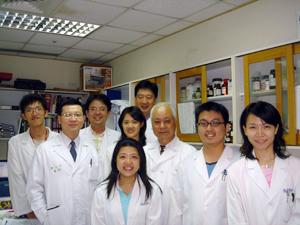| |
 |
|
|
 |
| |
 |
|
|
::: NTU research team has successfully developed cervical cancer vaccine, which is expected to effectively prevent and treat cancer
Over a long period of time, cervical cancer is the most prevalent cancer of women's malignancies in Taiwan. Conventional treatment modalities for cervical cancer such as surgery, radiotherapy, and cytotoxic chemotherapy, though effective to some extent, have a shortcoming in common: these methods may injure normal cells. Present researches have indicated that the development of cervical cancer has strong correlation with the infection of human papilloma virus (HPV). For this reason, taking HPV as a target to prevent and treat cervical cancer has become a new mode of research.
From Nov. 5th to 10th of this year, Dr. Wen-Fang Cheng, Associate Professor of the Graduate Institute of Clinical Medicine in National Taiwan University and Attending Physician of the Department of Obstetrics and Gynecology in National Taiwan University Hospital, participated the International Federation of Gynecology & Obstetrics (FIGO) Congress and announced the most recent results of cervical cancer vaccine researches, expecting that cervical cancer could be detected and treated at early stages in the future.
|
Dr. Cheng and his team designed different strategies on the development of cervical cancer vaccine, including protein-based vaccine, naked DNA vaccine and cell-based therapy. Among them, naked DNA vaccine had the most outstanding results in treatment of cervical cancer. They injected cancer cells via tail veins of mice to simulate the distant metastasis of cervical cancer cells to the lungs of mice. Seven days after the injection, the research team members started to treat the mice of lung metastasis with naked DNA vaccine. The results showed that mice which didn't receive the immunization of DNA vaccine had numerous tumors grown in their lungs after 35 days, but mice that received DNA vaccine didn't.
|
Dr. Wen Fang Cheng(second from the left), Dr. C. Y. Hsieh (third from the right) and lab members took the photograph together.
|
|
Dr. Cheng said that DNA vaccine could induce tumor antigen-cytotoxic T cells, which worked effectively in preventing naive mice from tumor growth and in treating tumor-burden mice. His research team has completed the animal experiments and now is in the process of applying naked DNA vaccine to the clinical trial. In the future, if the results of clinical trial prove to be satisfactory, the treatment of cervical cancer is expected to take a great leap forward.
At early stages of his research, Dr. Cheng, as a physician specializing in the study of gynecologic oncology, focused on the observation of tumor angiogensis in cervical cancer. Under the instruction of Prof. Chang-Yao Hsieh and Prof. Fon-Jou Hsieh, Dr. Cheng defined a parameter for angiogenesis ---Vascularity index (VI). VI by using color Doppler ultrasonography could identify the distribution of blood vessels within the tumors. This parameter gotten by this technique showed good correlations with disease progression and prognosis of cervical cancer patients.
This brand-new diagnostic technique can effectively evaluate patient's prognosis, but it didn't help much in treatment of cervical cancer patients. Therefore, after Dr. Cheng received his doctoral degree, he was assigned by the National Taiwan University Hospital to Johns Hopkins University to continue his post-doctoral research in Dr. T. C. Wu's laboratory and carried on with further deeper research on cancer prevention and treatment.
As the infection of HPV plays an important role in the causes of cervical cancer. From the perspective of immunology, in the course of an organism's growth and development, the immune response acts as a regulator. Immune system can protect its host from being infected by pathogens such as microorganisms or viruses of the external world, distinguish external invasions or other external antigens effectively, and take immune response to fight against probable stimulations of these external antigens.
The immune responses can be subdivided into two types: active and passive immunity. Active immunity means that the immunity is produced by host immune system after inoculation of antigen in advance, such as smallpox vaccine. The immunity inoculates a small amount of antigen to host in advance, and form a long term memory immune response. If the individual makes contact with the same or a similar pathogen, the immune system would produce strengthened immune response to fight against the pathogen. Passive immune system is induced by injection of antibodies, for example when a newborn get antibodies from his mother through breast-feeding. As opposed to active immunity, passive immunity can get immune response immediately, but it is unable to produce immune memory. Hence, if vaccines could be developed to prevent and eliminate cancer cells, or even promote immunity, they would be of great help to the cure of malignancies such as cervical cancer.
|
Copyright 2006 NTU Secretariat
|
|
Copyright © 2006 National Taiwan University
No. 1, Sec. 4, Roosevelt Road, Taipei, 10617 Taiwan(R.O.C.)
Phone: +886-2-3366-3366 Fax: +886-2-2362-7651
|


